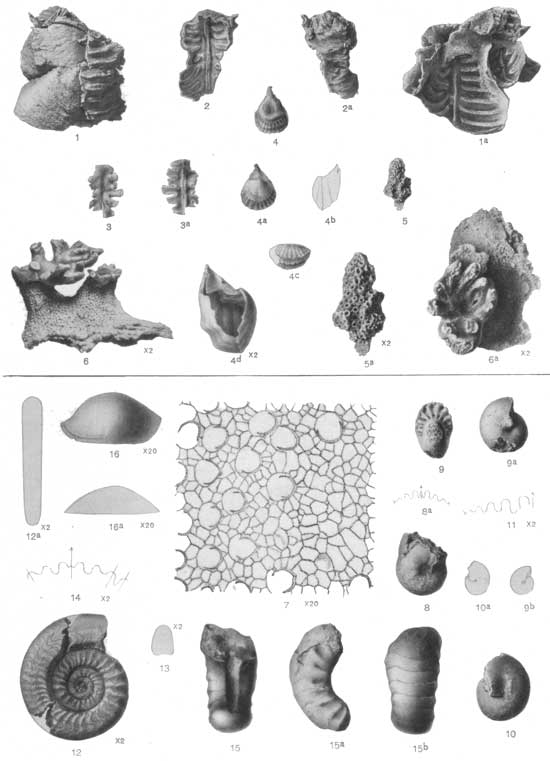
|
Geological Survey Professional Paper 58
The Guadalupian Fauna |
PLATES — PLATE XXV.
DELAWARE MOUNTAIN FORMATION, DIABLO MOUNTAINS.
|
LEPTODUS AMERICANUS H. sp. (p. 212). | |
| FIGS. 1 and 1a. |
A cluster of several specimens growing attached to one another. |
| 1. |
Seen from below |
| 1a. |
Seen from above. Delaware Mountain formation, Diablo Mountains (station 3764). |
| FIGS. 2 and 2a. |
An isolated ventral valve. |
| 2. |
Seen from above. The changing structure of the brachial ridges is well shown in this example. |
| 2a. |
Seen from below. Delaware Mountain formation, Diablo Mountains (station 3764). |
| FIGS. 3 and 3a. |
A dorsal valve. |
| 3. |
Outer (?) surface. |
| 3a. |
Inner (?) surface. Delaware Mountain formation, Diablo Mountains (station 3764). |
|
MEEKELLA ATTENUATA n. sp. (p. 205). | |
| FIGS. 4 to 4d. |
A slightly imperfect silicified specimen used as the type. |
| 4. |
Ventral view, |
| 4a. |
Dorsal view. |
| 4b. |
Side view in outline. |
| 4c. |
Anterior view. |
| 4d. |
Side view, X 2, showing through the break the dental plates of the ventral valve and the cardinal process of the dorsal valve. Delaware Mountain formation, Diablo Mountains (station 3764). |
|
CLADOPORA? TUBULATA n. sp. (p. 104). | |
| FIGS. 5 and 5a. |
Fragment of a zoarium. |
| 5. |
Side view. |
| 5a. |
Same, X 2. Delaware Mountain formation, Diablo Mountains (station 3764). |
|
THAMNISCUS DIGITATUS n. sp. (p. 148). | |
| FIGS. 6 and 6a. |
Specimen attached to a colony of Fistulipora. |
| 6. |
Seen from the side, X 2. |
| 6a. |
Seen from above, X 2. Delaware Mountain formation, Diablo Mountains (station 3764.) |
DELAWARE MOUNTAIN FORMATION, GUADALUPE MOUNTAINS.
|
FISTULIPORA GRANDIS var. GUADALUPENSIS n. var. (p. 125). | |
| FIG. 7. |
The typical specimen (see Pl. XVII, fig. 18.) Transverse section, X 20. Delaware Mountain formation, Guadalupe Point (station 2919). |
BASAL BLACK LIMESTONE, GUADALUPE MOUNTAINS.
|
AGATHOCERAS TEXANUM n. sp. (p. 501) | |
| FIGS. 8 and 8a. |
The type specimen. |
| 8. |
Side view. |
| 8a. |
Suture. Basal black limestone, Guadalupe Point (station 2967). |
|
PERITROCHIA EREBUS n. sp. (p. 499). | |
| FIGS. 9 to 9b. |
A rather small specimen. |
| 9. |
Apertural view, X 2. |
| 9a. |
Side view, X 2. |
| 9b. |
Same, natural size in outline. Basal black limestone, Guadalupe Point (station 2920). |
| FIGS. 10 and 10a. |
The largest specimen found. |
| 10. |
Side view, X 2. |
| 10a. |
Same, natural size in outline. Basal black limestone, Guadalupe Point (station 2920). |
| FIG. 11. |
The type specimen. Suture line, X 2. Basal black limestone, Guadalupe Point (station 2920). |
|
PARACELTITES ELEGANS n. sp. (p. 499). | |
| FIGS. 12 and 12a. |
An exfoliated specimen. |
| 12. |
Side view, X 2. |
| 12a. |
Ventral view, in outline, X 2. Basal black limestone, Guadalupe Point (station 2967). |
| FIG. 13. |
Fragment of another specimen. Cross section of a whorl, X 2. Basal black limestone, Guadalupe Point (station 2967). |
| FIG. 14. |
Another specimen. Suture line, X 2. Basal black limestone, Guadalupe Point (station 2967). |
|
FOORDOCERAS SHUMARDIANUM var. PRECURSOR n. var. (p. 498). | |
| FIGS. 15 to 15b. |
The typical specimen. |
| 15. |
Dorsal aspect of fragment. |
| 15a. |
Side view. |
| 15b. |
Ventral aspect. Basal black limestone, Guadalupe Point (station 2920). |
|
BAIRDIA aff. B. PLEBEIA Reuss (p. 510). | |
| FIGS. 16 and 16a. |
A silicified right valve. |
| 16. |
Side view, X 20. |
| 16a. |
Ventral view in outline, X 20. Basal black limestone, Guadalupe Point (station 2920). |
 |
| Plate XXV. (click on image for a PDF version) |
| <<< Previous | <<< Contents >>> | Next >>> |
pp/58/plate25.htm
Last Updated: 05-Dec-2008